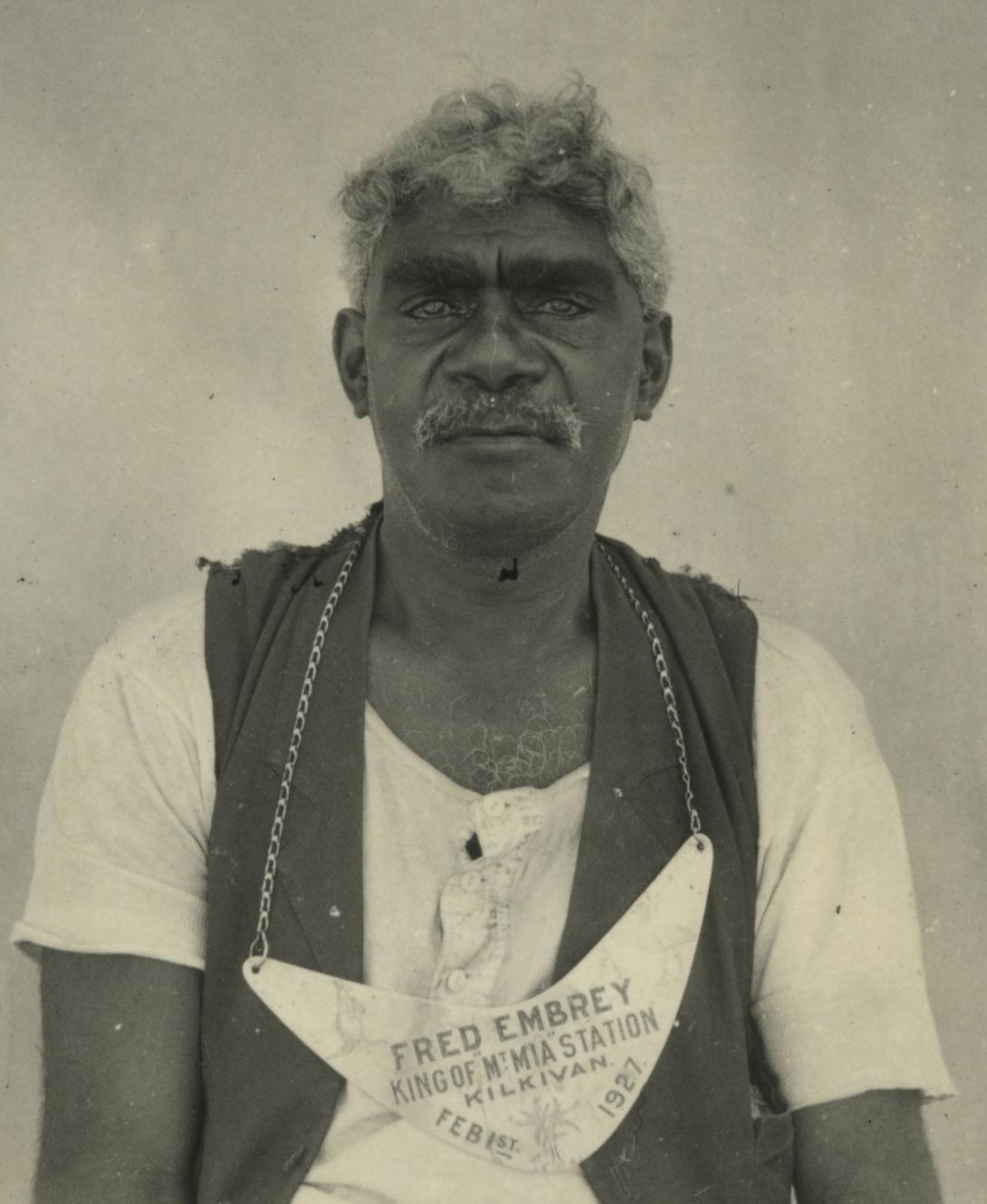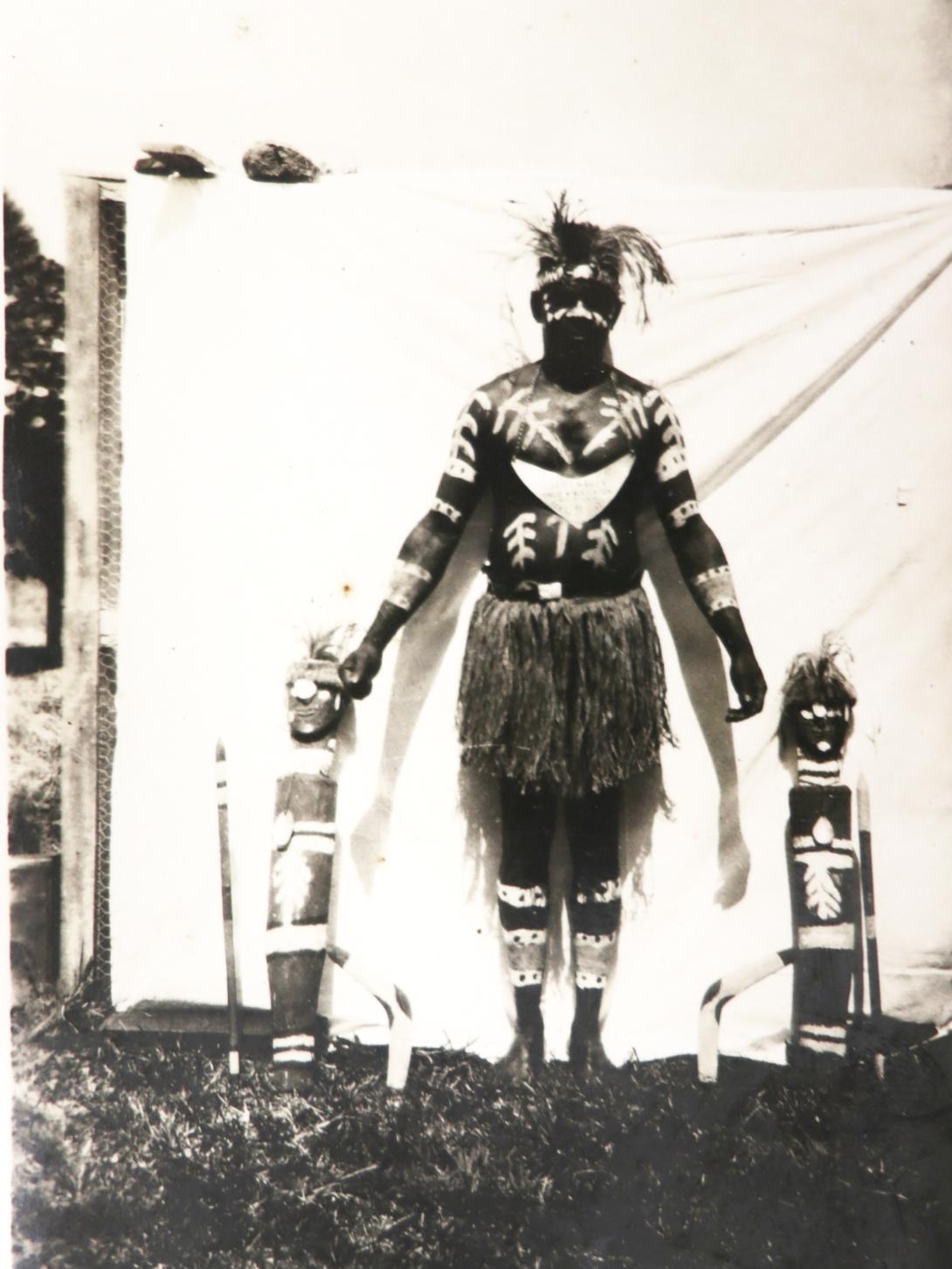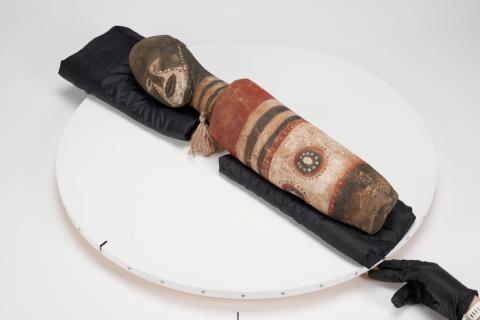Fred Embrey: Songman, sculptor, leader
By Michael Aird, Lindy Allen, Paul Memmott
Fred Embrey Research Project February 2024
Fred Embrey was a Kabi Kabi man whose Country was in the South Burnett and the Mary River region of south-east Queensland. According to anthropologist Norman Tindale (1900–93), Embrey was born at Widgee Widgee Station, west of Gympie, after 1867 and probably before 1874. Embrey had strong connections to Mt Mia, Kilkivan, Barambah Station and Manumbar. His father was ‘Embrey Ngimbirim, Kabi Kabi tr[ibe]’; his mother was ‘Lucy, Waka Waka [tribe]’;1 and his totem was the Carpet Snake.
Fred Embrey is remembered as a respected leader at Cherbourg in the 1920s and ’30s, as well as a celebrated composer, songman and choreographer. Songmen were held in high esteem across Aboriginal societies; some of Embrey’s songs continue to be performed at events across Queensland.2 His central role in leading the public performances of the Cherbourg and ‘South Burnett’ dancers is remarked upon in many press articles in the 1920s and 30s. What is perhaps less well known is that he was also an active maker of art objects.

Fred Embrey, Cherbourg, December 1938 / Photograph: Norman Tindale / Collection number: AAA346-4-20-1_Cherbourg – N1375 / Collection and image courtesy: South Australian Museum, Adelaide
Embrey lived most of his adult life at Cherbourg Aboriginal Settlement, where he died and was buried in the old cemetery in 1939. His immediate descendants today are the children of Penny Bond (nee Embrey), the only child of Dennis ‘Dinny’ Embrey, who died at Cherbourg in 1934. Dinny was the only son of Fred and his wife Sylvia Embrey (nee Cobbo). Penny’s children are Sylvia Bond, Margaret Bond, Alex Bond and Beverly Hand; they refer to their great-grandfather as Whardin, Yabba or Yabva.

Sylvia Bond, Judith Mather, Alex Bond and Beverley Hand at the launch of the ‘Voices of Our Elders’ exhibition, UQ Anthropology Museum, 23 February 2024 / Photograph: Michael Aird
‘King Freddie’
As a key figure and ‘king’ at Cherbourg, Fred Embrey was at the forefront when distinguished guests or government officials visited, including being amongst the official party to welcome the Duke of Gloucester to Cherbourg in 1934. In August 1938, a newspaper reported how the Minister for Health and Home Affairs, Mr EM Hanlon ‘[a]fter watching the events and meeting leading citizens . . . had time for a chat with Fred Embrey, the king of Mt Mia Station Blacks’.3
Bestowing Aboriginal men with breastplates was a practice instigated by early European settlers to give status to ‘cooperative’ individuals, regardless of their status within their own community. Aboriginal society never had ‘kings’; this convention was imposed upon Aboriginal people by settlers. Fred Embrey was given this breastplate in recognition of his strong traditional connections to the Country in the region of Mt Mia Station near Kilkivan, yet the Country that Embrey was associated with was much broader than this.
No records have been located as to the circumstances surrounding its presentation, but it is held by Embrey’s descendants. Brisbane radio and television personality Jamie Dunn, who returned the breastplate to the family in 2012, had purchased it breastplate at Rita Rainbow’s Marcoola antique shop on Queensland’s Sunshine Coast.

Fred Embrey with the sculptures currently held at Queensland Museum, 1932–33 / Betty McKenzie Collection / Collection and image courtesy: Queensland Museum Network, Brisbane
Access the full research report: FRED EMBREY SCULPTURE RESEARCH PROJECT [39pp PDF 18.5mb].
- Norman Tindale, data cards, 1 December 1938, AA346-420-20-1, Cherbourg N1375, 1938a; genealogy sheet 30, 1 December 1938, 1938b, South Australian Museum.
- Alfred Howitt, The Native Tribes of South-East Australia, Aboriginal Studies Press, Canberra, 1996; first published in 1904, p.414.
- ‘Mr Hanlon has a busy day at Murgon’, The Telegraph, Brisbane, 27 August 1938, p.9.
Digital story context and navigation
A CEREMONIAL FIGUREExplore the story





